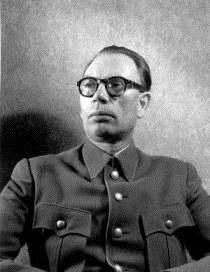Background of the case
On March 10, 1946, Andrey Andreyevich Vlasov, a general of the Soviet Red Army, was captured by germany during World War II. He then surrendered to the German army, joined the Nazi Germany camp, and was a traitor who had been a stench in history for thousands of years, and was eventually hanged.
What was the reason why Vlasov, the new general of the Soviet Army, who had been Stalin's weapon, was captured by the Germans and surrendered, turning his gun on his former comrades-in-arms. Please follow the editor into the case of Vlasov, the number one traitor in the Soviet Union, and explore the truth behind the case together.

Biography
Vlasov was born on September 1, 1901, to a middle-peasant family. After joining the Red Army in 1919, he participated in the Russian Civil War and performed well. In 1930, Vlasov became a member of the United Communist Party. In 1938, he was sent to China as a jinshi adviser to help Chiang Kai-shek train his army, and after returning to the Soviet Union, he appointed the commander of the 99th Infantry Division.
In 1941, Vlasov led a strong army to block the Germans on the line of the Moscow Canal, and in the famous Battle of Moscow, he served as the vanguard, and was subsequently reused by Stalin as commander of the Second Assault Army.
In March 1942, the Germans encircled Vlasov's Army Group. In June 1942, Vlasov broke through the siege and opened a passage on the right bank of the Polisti River, allowing a group of Soviet troops to successfully escape, but eventually the Germans closed the breakthrough. Vlasov became a prisoner of the German 38th Infantry Corps in a small village called Piatenitsa.
Captured and mutinous
Vlasov quickly defected and surrendered in the Nazi concentration camps, completing his transformation from hero of the Red Army to an accomplice of fascism. During the horrific situation in the concentration camp, Vlasov became frightened, and the relentless torture caused Vlasov to abandon his resistance and begin to cooperate with the Germans.
Despite Vlasov's willingness to cooperate, Himmler and Nazi high-ranking figures dismissed him. It was not until September 16, 1944, that Himmler met with Vlasov and allowed him to form a "Russian Liberation Army" under the command of the German army.
On December 19, 1944, the Russian People's Liberation Army Air Force was officially established. The total strength of the People's Liberation Army is 50,000 according to incomplete statistics, composed of captured soldiers of the former Soviet Army and Russian expatriates living in Europe.
Second rebellion
Vlasov and his group of Russian national scum knew that if Germany was defeated, they would not be able to escape the punishment of the Soviet government, so they martyred Hitler with all their hearts.
On February 9, 1945, Vlasov's Russian Liberation Army took part in actual combat in the east; in April, Bunyachenko, who did not want to bleed the Germans anymore, led his troops south. To join other units of the Russian Liberation Army in the Allip region, Vlasov's headquarters was in Carlsbad.
In the spring of 1945, Vlasov, who was looking for a way out for his army, established contacts with two neutral states, Sweden and Switzerland. Many Russian rebels loyal to the Germans defected to Vlasov, and the Plakmen's army grew to about 100,000 men.
Look for the way back
At the end of April 1945, an armed anti-fascist uprising broke out in Czechoslovakia, and the Russian Liberation Army helped the rebels in order to think that the Czechoslovak government could intercede for them. In May, the Russian Liberation Army captured a major part of Prague and the Germans were forced to retreat.
Upon learning of what the Soviets were doing, Stalin immediately ordered Konev's Soviet First Ukrainian Front to attack Prague, and the Czech president tore up the agreement on joint struggle with the Russian Liberation Army.
Vlasov led the Russian Liberation Army all the way westward, and in June 1945, surrendered to the American army. The U.S. military unconditionally returned the captured Soviet citizens to the Soviet army, and Vlasov was repatriated to the Soviet Union, where he was sentenced by hanging by the Supreme Military Tribunal of the USSR.
Write at the end
During the Period of the Great Patriotic War, Stalin's autocracy did not have the concept of "prisoner of war", only "deserters, traitors of the motherland and enemies of the people". The commander was authorized to shoot everyone to avoid death as a prisoner.
Under any rule, the condemnation of traitors is inevitable, and betrayal of oaths and the state system of one's own homeland will not be forgiven by any regime in the world.